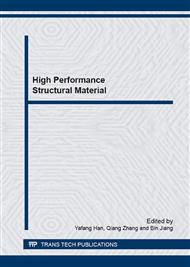[1]
R.E. Brown, Future of Magnesium Developments in 21st Century, in: Presentation at Materials Science &Technology Conference, Pittsburgh, PA, USA, October 5-9, (2008).
Google Scholar
[2]
A.A. Luo, K. Sadayappan, Technology for Magnesium Castings, American Foundry Society, IL. (2011) 29-47.
Google Scholar
[3]
M.M. Avedesian, H. Baker, Magnesium and Magnesium alloys, ASM International, Materials Park, OH, (1999).
Google Scholar
[4]
E.L. Zhang, D.S. Yin, L.P. Xu, L. Yang, K. Yang, Microstructure, mechanical and corrosion properties and biocompatibility of Mg-Zn-Mn alloys for biomedical application, Mat. Sci. eng. C. 29 (2009) 987-993.
DOI: 10.1016/j.msec.2008.08.024
Google Scholar
[5]
H. Somekawa, T. Mukai, Fracture toughness in a rolled AZ31 magnesium alloy, J. Alloy Comp. 417 (2006) 209-213.
DOI: 10.1016/j.jallcom.2005.07.073
Google Scholar
[6]
D.K. Xu, L. Liu, Y.B. Xu, E.N. Han, Effect of microstructure and texture on the mechanical properties of the as-extruded Mg–Zn–Y–Zr alloys, Mater. Sci. Eng. A 443 (2007) 248-256.
DOI: 10.1016/j.msea.2006.08.037
Google Scholar
[7]
N. Stanford, The effect of calcium on the texture, microstructure and mechanical properties of extruded Mg–Mn–Ca alloys, Mate. Sci. Eng. A 528 (2010) 314-322.
DOI: 10.1016/j.msea.2010.08.097
Google Scholar
[8]
X. Gao, J.F. Nie, Scripta Mater. 56 (2007) 645-648.
Google Scholar
[9]
X. Zeng, Y. Wang, W. Ding, A. Luo, A. Sachdev, Metall. Mater. Trans. A 37 (2006) 1333-1341.
Google Scholar
[10]
X.N. Gu, Y.F. Zheng, A study on alkaline heat treated Mg–Ca alloy for the control of the biocorrosion rate, Biomaterials. 30 (2009) 484-498.
DOI: 10.1016/j.actbio.2009.01.048
Google Scholar
[11]
S.X. Zhang, X.N. Zhang, Research on an Mg-Zn alloy as a degradable biomaterial, Acta Biomater. 6 (2010) 626-640.
Google Scholar
[12]
H. Okamoto, Comment on Mg-Zn (magnesium-zinc). J Phase Equilibria Diffus. 15(1994) 129-130.
DOI: 10.1007/bf02667700
Google Scholar
[13]
C.J. Boehlert, The microstructure, tensile properties, and creep behavior of Mg–Zn alloys containing 0–4. 4 wt. % Zn, Mater. Sci. Eng. A 417 (2006) 315-321.
DOI: 10.1016/j.msea.2005.11.006
Google Scholar
[14]
Y.W. Song, E.H. Han, The effect of Zn concentration on the corrosion behavior of Mg-xZn alloys, Corros Sci. 65 (2012) 322-330.
DOI: 10.1016/j.corsci.2012.08.037
Google Scholar
[15]
K. Pettersen, O. Lohne, N. Ryum, Dendrite solidification of magnesium alloys AZ91, Metall. Trans. A. 21 (1990) 221-230.
DOI: 10.1007/bf02656439
Google Scholar
[16]
M. Paliwal, In-Ho Jung, The evolution of the growth morphology in Mg-Al alloys depending on the cooling rate during solidification, Acta Mater. 61 (2013) 4848-4860.
DOI: 10.1016/j.actamat.2013.04.063
Google Scholar
[17]
M. Paliwal, In-Ho Jung, Microstructural evolution in Mg-Zn alloys during solidification: An experimental and simulation study, J. Cryst. Growth. 394 (2014)28–38.
DOI: 10.1016/j.jcrysgro.2014.02.010
Google Scholar
[18]
M. Mabuchi, M. Kobata, Y. Chino, Tensile properties of directionally solidified AZ91 Mg alloy, Mater. Trans. 44 (2003) 436-439.
DOI: 10.2320/matertrans.44.436
Google Scholar
[19]
G.W. Chang, S.Y. Chen, C. Zhou, Relationship between solid/liquid interface and crystal orientation for pure magnesium solidified in fashion of cellular crystal, Trans. Nonferrous Met. Soc. China 20 (2010) 289-293.
DOI: 10.1016/s1003-6326(09)60136-9
Google Scholar
[20]
Djordje. Mirkovic, Rainer. Schmid-Fetzer, Directional Solidification of Mg-Al alloys and microsegregation study of Mg alloys AZ31 and AM50: Part Ⅰ. Methodology, Metall. Mater. Trans. A 40 (2009) 958-973.
DOI: 10.1007/s11661-009-9787-3
Google Scholar
[21]
M. Chen, X.D. Hu, The microstructure prediction of magnesium alloy crystal growth in directional solidification, Comp. Mater. Sci. 79 (2013) 684–690.
DOI: 10.1016/j.commatsci.2013.07.030
Google Scholar
[22]
J.W. Fu, Y.S. Yang, Formation of the solidified microstructure in Mg–Sn binary alloy, Cryst. Growth 322 (2011) 84-90.
DOI: 10.1016/j.jcrysgro.2011.03.026
Google Scholar
[23]
G.X. Hu, X. Cai, Y.H. Rong (Eds. ), Fundamentals of Materials Science, Shanghai Jiao Tong University Press, Shanghai, China, 2000. pp.298-300.
Google Scholar
[24]
H.Z. Fu, J.J. Guo, L. Liu (Eds. ), Directional Solidification and Processing of Advanced Materials, Sciences Press, Beijing, China, 2008. pp.224-233.
Google Scholar


